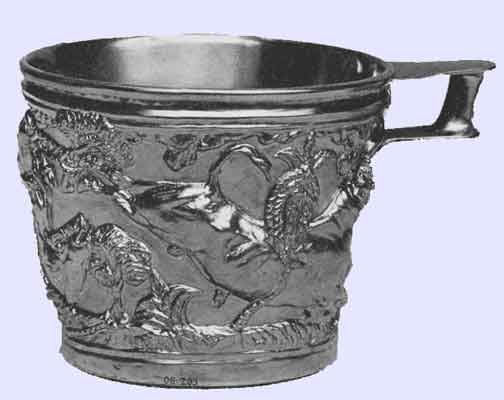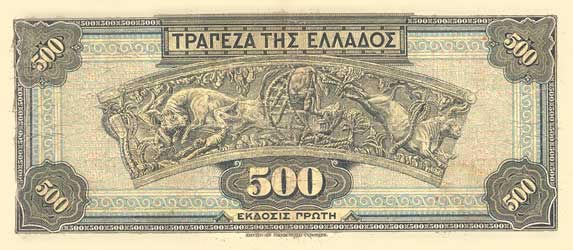.

One of the Mycenaean Vaphio Cups, c. 1500 BC, National Museum Athens

Drawing of the reliefs
The greatest triumph of the goldsmith's art in the "Mycenaean" period does not come from Mycenae. ... gold cups .. were found in 1888 in a bee-hive tomb at Vaphio in Laconia. Each cup is double; that is to say, there is an outer cup, which has been hammered into shape from a single disc of gold and which is therefore without a joint, and an inner cup, similarly made, whose upper edge is bent over the outer cup so as to hold the two together. The horizontal parts of the handles are attached by rivets, while the intervening vertical cylinders are soldered. The designs in repousse work are evidently pendants to one another. The first represents a hunt of wild bulls. One bull, whose appearance indicates the highest pitch of fury, has dashed a would-be captor to earth and is now tossing another on his horns.
A second bull, entangled in a stout net, writhes and bellows in the vain effort to escape. A third gallops at full speed from the scene of his comrade's captivity. The other design shows us four tame bulls. The first submits with evident impatience to his master. The next two stand quietly, with an almost comical effect of good nature and contentment. The fourth advances slowly, browsing. In each composition the ground is indicated, not only beneath the men and animals, but above them, wherever the design affords room. It is an example of the same naive perspective which seems to have been employed in the Tirynthian bull-fresco ..... Evidently we have here the work of an artist who drew his inspiration directly from nature. A History Of Greek Art, by F. B. Tarbell

Greece, 1932 , 500 Drachmae with the Vaphio Cup
<| Ancient Greece
Science, Technology , Medicine , Warfare, , Biographies , Life , Cities/Places/Maps , Arts , Literature , Philosophy ,Olympics, Mythology , History , Images Medieval Greece / Byzantine Empire Science, Technology, Arts, , Warfare , Literature, Biographies, Icons, History Modern Greece Cities, Islands, Regions, Fauna/Flora ,Biographies , History , Warfare, Science/Technology, Literature, Music , Arts , Film/Actors , Sport , Fashion --- |
Retrieved from "http://en.wikipedia.org/"
All text is available under the terms of the GNU Free Documentation License
